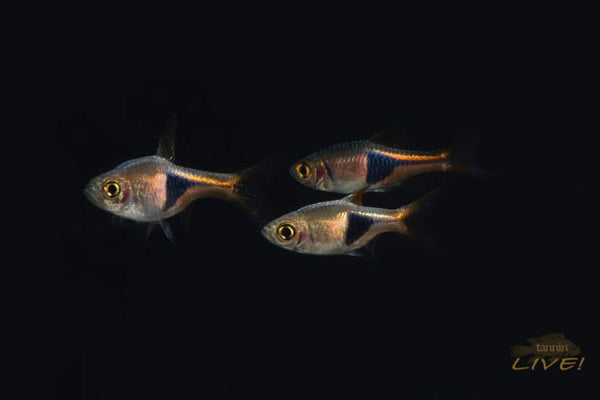- Continue Shopping
- Your Cart is Empty
"R" is for Rasbora...
"Rasbora."

The name alone evokes something. A feeling. A sort of romantic fantasy we all have about a far-off, exotic place, filled with sights and wonders and beauty.
Malaysia. Indonesia. Sumatra. Borneo.
The litany of locations from which the fishes we collectively call "Rasbora" is like a veritable "who's who" of amazing ecological diversity and beauty. It goes without saying that the surprisingly diverse group of fishes that are placed under this generic moniker are as beautiful, fascinating, and evocative as the habitats from which they come.

More than just "Asia's answer to Tetras!", these fascinating fishes offer diversity, color, grace, and interest to any aquarium- particularly one set up to replicate some of the conditions of their natural habitats. We receive fair amount of questions asking about what botanicals and such would be appropriate for these amazing fishes in the aquarium...
Let's take a quick look at this!

It would be an over-generalization (which we as hobbyists tend to be guilty of, right?) to simply say that they all come from "soft, acidic water" as has been the case for many years. I mean, it's difficult to argue otherwise, as most of them DO come from such habitats.

That being said, as with any species, it goes without saying that you should study the specific locales and habitats from which the species you're into hail, and make your stocking and aquascaping/habitat design decisions with that information.

Nonetheless let's forge ahead and take a broad, likely over-generalized look at some of the materials and ideas for a setup featuring fishes from this unique collective of Cyprinids we call "Rasbora!"

Now, first off, most of the ones we're interested tend to come from dark, soupy, highly acidic waters. Many of these habitats, ranging from critically-endangered peat swamps to forest streams and small pools, are chocked with leaves and other botanical materials, such as branches and seed pods from the surrounding terrestrial habitats.
An of course, this is right up our alley, so to speak, right?
Yep!
You could hardly go wrong in stocking your Rasbora-centric tank with leaf litter. And of course, we all know a thing or two about leaf litter, right? And of course, since most of them are rather small, if your "scale-obsessive" like I am, you want to go with smaller leaves. Our recommendations would be our latest "BFF", Texas Live Oak Leaves, the ever-appropriate Malaysian Yellow Mangrove Leaves, and the beautiful fave, Guava Leaves!
Any of these individually, or in concert with each other, will form a beautiful, functional leaf litter bed, even in a small aquarium. The tannins imparted by them, and the "matrix" they provide for microorganism growth are terrific side benefits!

And of course, I'd be remiss if I didn't at least remind you to explore the possibility of aquatic plants in your Rasbora tank, right? In addition to the old favorites, Cryptocoryne, you could utilize the much-loved Bucephalandra, some mosses, and the awesome Rotala. All do quite well in these tinted, acidic environments- and they look amazing, too!

From a botanical perspective, I'd consider the types of plants and trees that surround the habitats of the specific species you're working with. I'd say that, generically, you could incorporate representations of "regionally-appropriate" materials, like Banana Stem Pieces, Fishtail Palm Stems, "Rio Fruta", and, perhaps, some peices of catappa bark to simulate the accumulation of materials which was into the waters during the rains.

Sure, that's not an exhaustive list, but it gives you a starting point to narrow down some choices. Each one of them is both interesting from an aesthetic standpoint, and imparts some tannins and humic substances to the water, as well as fosters biofilms and microorganism growth from the "functional" side.
As we enable more self-curation based on specific fish and habitats in the future (Huh? What are you taking about? Stay tuned!) on our site, we hope that you'll be able to easily ascertain what really provides the look and feel your trying to achieve!

This almost embarrassingly general and cursory look is to hopefully whet your appetite and answer a few of the questions we receive about "What goes with this fish...?" Obviously, we can and will go much deeper at a later time, but this is a start!
Stay curios. Stay inspired. Stay empowered. Stay enthralled. Stay creative...
And Stay Wet.
Scott Fellman
Tannin Aquatics







Scott Fellman
Author